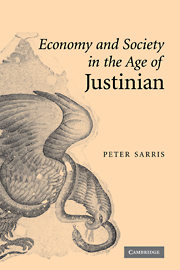REVIEW: Peter Sarris, Economy and Society in the Age of Justinian.

Peter Sarris, Economy and Society in the Age of Justinian. Cambridge: Cambridge University Press, 2006. Pp. viii, 258. ISBN 10: 0-521-86543-3. ISBN 13: 978-0-521-86543-2. $80.00.
Reviewed by M. Shane Bjornlie, Claremont McKenna College (sbjornlie@cmc.edu)
Word count: 2066 words
As the latest crest in an already formidable groundswell of scholarship devoted to the late-antique economy, Sarris' monograph contributes an impressive and crisply written reconstruction of the late-Roman local economy using the Oxyrhynchus papyri of Egypt. Sarris situates a very specific kind of economic regime, the elite estate, within the theater of eastern imperial politics, concentrating on Justinian's reign in the sixth-century, while also taking into account developments of the fourth through the seventh centuries. The book is of immediate interest to anyone concerned with eastern imperial politics and polemics, fiscal administration, agrarian history, and the formation of elite identity.
Sarris reads in the fragmentary Egyptian papyri evidence for a mode of elite agricultural exploitation that was rationalized and consistent, heavily monetized and commercialized, and the result of a relationship with the imperial court that was opportunistic on the part of local provincial families. The book forms an interesting, although not complacent, companion to work on elite economic regimes by Jairus Banaji and, to some degree, Sarris responds to the work of Banaji (vii).
Read More
Table of Contents
Source: BMCR, Cambridge Univ. Press

<< Home